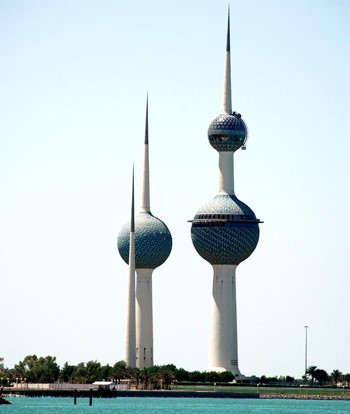Kuwait Towers
The following information is adapted from the website: www.kuwaitembassy.az
A group of three slender towers that symbolizes Kuwait’s economic resurgence in the 1960s and 70s. They are a world cultural as well as touristic landmark. Standing on a promontory into the Arabian Gulf, Kuwait towers were officially inaugurated in 1979.
Kuwait Towers suggest a combination of traditional Islamic design and modern architectural themes. The easy visibility and popularity of the towers with photographers is also due to the fact that there are no other high rise buildings in the general area of the Kuwait Towers. The Towers have come to signify the prosperity that has boosted this previously sleepy backwater country into the world’s tenth richest country per capita.

Design and construction:
The plan to construct Kuwait Towers dates from 1962, less than a year after Kuwait achieved its independence. The design was by Danish architect Malene Björn and Swedish architect Sune Lindström of Vatten-Byggnadsbyzan (VBB). It was officially approved in 1971. The Belgrade-based contractor Union-Inzenjering was assigned most of the structural work which was completed between 1975 and 1976.
The two taller towers feature large spheres in their designs. In the case of the main tower, which is 187 meters high, there are two and on the second there is just one. The top sphere on the main tower contains observation platforms, shops, and a snack bar. This main sphere revolves at a rate of 30 minutes per full rotation and offers views of the city and the Arabian Gulf from a height of 123m. It is the ideal place to enjoy a 360º view of Kuwait City and its surroundings.
On both the main tower and the second tower the larger lower spheres function as water tanks containing up to 9000 cubic meters of liquid per tower. The third and smallest of the towers contains special illumination equipment used to light up the other two towers. This allows special moving images to be projected onto the Towers at night.The Towers were built of prestressed concrete and reinforced concrete. The three spheres are covered in approximately 41,000 enamelled steel discs in eight shades of green, blue and gray, recalling the tiled domes of historic mosques. Around the spheres, the steel discs are arranged in spiral patterns. Kuwait Towers were awarded the Aga Khan award for architecture in 1980.
-
Historical information
Seven months of Iraqi occupation which began on August 2nd, 1990, when Saddam Hussein of Iraq invaded Kuwait left an ugly mark on Kuwait. Kuwait salvaged its sovereignty after a 100-hour ground campaign that began on February 25th. Saddam’s troops were guilty of sabotage intended to wipe out all reminders of an independent Kuwait. Iraqi soldiers deliberately shattered the Towers’ electrical utilities and wrecked interior facilities besides causing damage to the Towers’ exteriors with gunfire and shrapnel.
-
The damage sustained to the Kuwait Towers (estimated to be 75 percent) was repaired throughout the remainder of 1991 and well into 1992. The necessary technical as well as leisure facilities were restored to their original condition. The refurbishment cost was an estimated KD 2 million. On December 26th of 1992, it was an inspirational occasion for proud Kuwaiti citizens as the Kuwait Towers were officially reopened to the public by Nasser Al-Roudhan, Finance and Planning Minister at that time.
